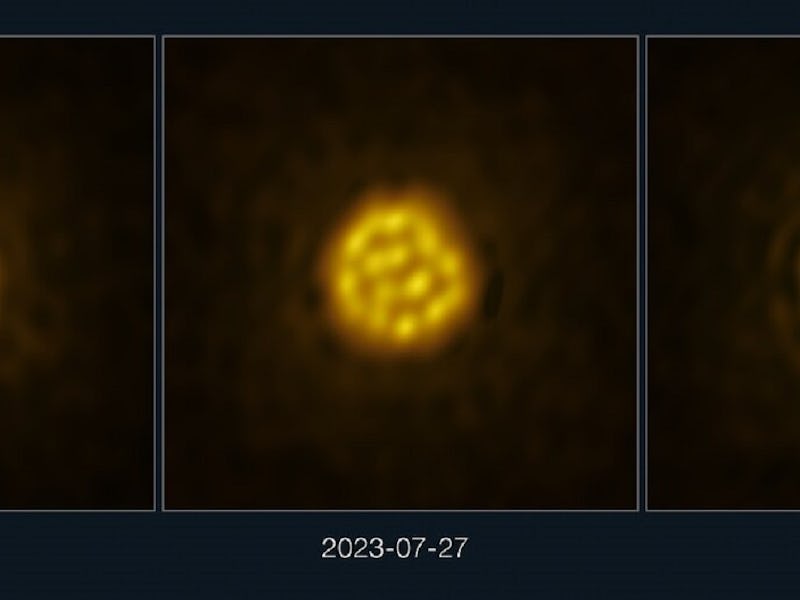The First Movie Of A Distant Star's Surface Offers A Glimpse Of Our Own Fiery Finish
Old age on a star isn’t pretty — but it is bubbly.

Scientists recently captured a movie of the roiling surface of giant, aging star 180 light years away.
A team of astrophysicists assembled a movie from a month’s worth of data, which showed the constantly-shifting surface of red giant star R Doradus. And it turns out that the vast oceans of hot plasma that make up the middle and outer layers of huge, geriatric stars churn much faster than small, middle-aged ones like our Sun, for reasons that physicists are still trying to figure out. Chalmers University of Technology astrophysicist Theo Kouri and his colleagues published their work in the journal Nature.
Astronomers compiled the short video from a month’s worth of images taken with the ALMA telescope in Chile.
Bubble, Bubble, Thermonuclear Trouble
Late last summer, in the Atacama Desert of Chile, Kouri and his colleagues pointed the 66 dish antennas of the Atacama Large Millimeter/ submillimeter Array at a baleful red star 180 light years away. The star, called R Doradus, is about the same mass as our Sun, but it’s much older – and about 350 times wider. Kouri and his colleagues used ALMA’s data to pick out shifting patterns of light and dark on the star’s surface: immense blobs of hot plasma bubbling upward, each wide enough to swallow 75 Suns.
Over the course of about a month, each of these upwelling streams of plasma slowly cooled and sank downward into the depths of the star, then rose to the surface again.
It’s a familiar process called convection. As any fluid gets heated from below, its molecules start to spread out and move around. This makes the fluid less dense than the fluid around it, so it floats upward. At the surface, the column of hot fluid flows a short distance, then cools and sinks down again. The process ends up forming a constant churn of material rising to the surface and sinking back to the depths. Sound familiar?
Physicists call this cycle a convection cell, and it works the same way whether we’re talking about a pot of water boiling on a hot stove, molten rock deep in Earth’s mantle heated by our planet’s core, or the plasma of a star heated by thermonuclear fusion deep in its fiery heart.
The grainy texture of the Sun’s surface is thanks to plasma bubbling up to the surface and then sinking again. For comparison, each of the bubbles observed on R Doradus is about 75 times bigger than our whole Sun.
“Convection creates the beautiful granular structure seen on the surface of our Sun, but it is hard to see on other stars,” says Kouri in a recent statement. This is the first time astrophysicists have ever recorded the churning motion of convection cells on another star.
Astronomers have captured still images of the convection cells on another star, a red giant called π1 Gruis, with the (not very creatively named) Very Large Telescope back in 2017. But while those images revealed the granular pattern of convection cells on the star’s surface, they didn’t capture the motion. That’s what ALMA just did, for the first time. And in the process, Kouri and his colleagues discovered something surprising: convection cells move much faster on R Doradus than in our Sun.
After several decades of watching convection happen in our Sun’s middle layers, astrophycists have a pretty good idea of how it works — and they thought they had a pretty good idea of how long the process should take in stars of different sizes and temperatures. But the month it takes plasma bubbles to cool, sink, and rise again on R Doradus is much faster than Kouri and his colleagues had predicted and they’re not yet sure why the star’s plasma churns so aggressively.
“We don’t yet know what is the reason for the difference,” says Chalmers University astrophysicist Wouter Vlemmings, a coauthor of the study, in a recent statement. “It seems that convection changes as a star gets older in ways that we don’t yet understand.”
Answering that question could shed some light on our own Sun’s future; R Doradus is a preview of what our Sun will look like in about 5 billion years, when it runs of hydrogen to fuse at its core and graduates to helium fusion. In the process, the Sun’s outer layers will swell outward, engulfing the inner Solar System in roiling layers of plasma.